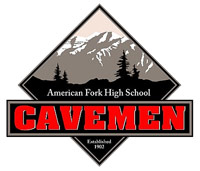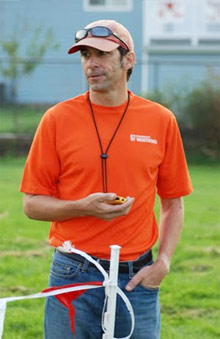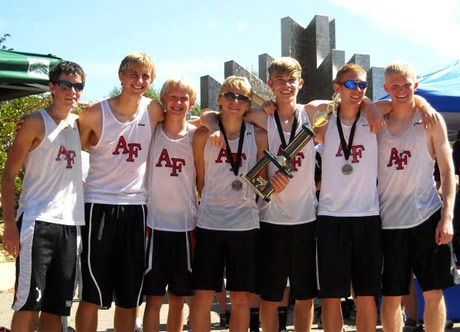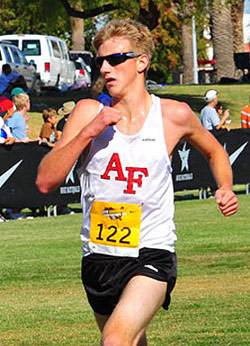 |
 |
 |
|
|
 |
 |
 |


|
| | True cross country fans know our sport is more of a team event than most outsiders realize, yet there are plenty of individual standouts as well. So, while honoring the tradition we have started at DyeStat with Interval Sessions, which introduced you to the top individuals in both track and XC, we launch Fall 2009 with "Star Squad Spotlight," giving you a chance to get to know not just the top individual runners in the country, but also the best teams.
| | | squad | american fork ut boys
9.17.09
by Dave Devine, DyeStat Senior Editor
 A quick glance at results from the first five incarnations of the Nike National cross country championships (first called NTN, then NXN) finds squads from Utah-- boys and girls-- routinely battling their way to finishes well within the top 10. The boys of Mountain View UT scored top five finishes the first two years of the event. Go back further, to the decades when hypothetical national titles were awarded by the Harrier Magazine poll, and you'll discover no shortage of Utah teams occupying the top shelf at autumn's end. Now comes the latest loaded team from the land of the Great Salt Lake, the American Fork UT boys, coached by 12-year mentor Timo Mostert. Ranked US#13 in the latest DyeStat Elite/ESPN RISE Fab 50, and occupying the two-slot in a Southwest Regional list littered with fellow Utah teams, the Cavemen of American Fork brought back 6 of 7 from a 2008 unit which was Utah 5A runners-up and NXN SW fourth placers. That fourth place regional finish only whet the appetite of the young squad, and they're hoping the 2009 campaign can end with seven sets of Cavemen spikes toeing the line at Portland Meadows. A quick glance at results from the first five incarnations of the Nike National cross country championships (first called NTN, then NXN) finds squads from Utah-- boys and girls-- routinely battling their way to finishes well within the top 10. The boys of Mountain View UT scored top five finishes the first two years of the event. Go back further, to the decades when hypothetical national titles were awarded by the Harrier Magazine poll, and you'll discover no shortage of Utah teams occupying the top shelf at autumn's end. Now comes the latest loaded team from the land of the Great Salt Lake, the American Fork UT boys, coached by 12-year mentor Timo Mostert. Ranked US#13 in the latest DyeStat Elite/ESPN RISE Fab 50, and occupying the two-slot in a Southwest Regional list littered with fellow Utah teams, the Cavemen of American Fork brought back 6 of 7 from a 2008 unit which was Utah 5A runners-up and NXN SW fourth placers. That fourth place regional finish only whet the appetite of the young squad, and they're hoping the 2009 campaign can end with seven sets of Cavemen spikes toeing the line at Portland Meadows.
DyeStat Senior editor Dave Devine caught up with Coach Mostert and his current #2 man, senior captain Robby Lee, just before the squad headed out for practice.
 After finishing as runner-up at the Utah state meet last season, and then fourth at NXN Southwest with a young team, what did you carry forward from that experience as you looked toward this year and higher aspirations in 2009? After finishing as runner-up at the Utah state meet last season, and then fourth at NXN Southwest with a young team, what did you carry forward from that experience as you looked toward this year and higher aspirations in 2009?
Coach Timo Mostert (right): The boys came away from the Southwest Regionals really hungry, knowing that we were that close with such a young team. Four of the boys on varsity last year were rookies, and two of them were freshman, so they were really excited about this year. When we started up at the beginning of the summer everybody was on the same page, and thought that if we worked hard and kept focused then we could break through and make it to Nationals this year. We were chasing Alta UT all last year, so to see them go [to NXN], and then to see them indoors in their gear, that motivated the boys. It was like, ‘We want that for us.’
Robby Lee, senior captain: When we were at the Southwest Regional last year, we realized that we had 6 of the 7 coming back for 2009, and we were already looking forward to coming back. We also knew we could go for the state championship, where we’ve had quite a few second places, but haven’t won it yet. And with us getting fourth at NXN Southwest, and watching Alta, another team from our state, go to Nationals, it boosted our confidence and helped us realize that the New Mexico teams aren’t these overwhelming teams. We can get in there, we can beat some of them, and we can get to Nationals too.
Can you talk about some principles or training philosophies, as a coach, which underpin or serve as cornerstones for the program at American Fork?
Coach Mostert: This is my twenty-second year coaching [12th at American Fork], and I’ve always liked the stuff from [Bill] Bowerman and Arthur Lydiard. I read a lot of Lydiard when I was a young coach, and then incorporated it for our own specific case here at altitude, where we’ve got opportunities to run in the mountains a lot. I’ve tried to take the best of everything that seems to work, going through trial and error over the years and pulling things from my high school coaches and college coaches. What we’re doing now seems to work well. We like to do a lot of distance, especially in the summer. Long runs, some kind of fartlek at least once a week, an interval or a repeat workout. The other day we did 5x1000 meters on grass…usually about 3 miles of intervals or repeats, depending on the time of year. We like to do anaerobic threshold runs, the same stuff everybody else does. We do morning runs together for recovery, about a half hour jog together every morning. We do some light pull-ups and dips and sit-ups and then get ready for school. It wakes the boys up, but it also helps them recover from the hard workouts in the afternoon.
If someone was to ask, ‘What are the hallmarks of a Caveman team? What things should we expect, year in and year out, from a squad at American Fork?’— can you identify the things we’d always see from your teams?
 Coach Mostert: I think the big thing is that we get along with all the other teams. We have activities in the summer where we invite other teams from the Valley to join us up in the mountains for a run. One of the top kids in the state has come down and run with us in the summer when he didn’t have someone to train with at his school. We’re friendly with everybody, try to get along, but on the race course we do our best to beat everybody. Coach Mostert: I think the big thing is that we get along with all the other teams. We have activities in the summer where we invite other teams from the Valley to join us up in the mountains for a run. One of the top kids in the state has come down and run with us in the summer when he didn’t have someone to train with at his school. We’re friendly with everybody, try to get along, but on the race course we do our best to beat everybody.
There’s a saying on your team’s website: “You can’t race hardcore unless you train hardcore!” Robby, for your group, what’s the meaning of that? How does your team take that saying and apply it during the season?
Robby Lee: We believe that you have to practice how you race. We race like we want to be the top team in the state, and a state contender every year, and the only way to do that is to have those strong practices too. We start off practicing hardcore and keep it that way.
Although there have been many great teams that have come out of Utah over the years, when discussions arise about the best areas for high school cross country in the country, people tend to focus on places like Illinois, New York, California, and Spokane WA. Do you think some people aren’t aware of the rich tradition in Utah, and can you talk a little bit about that tradition?
Coach Mostert: I think the coaches and the people who have been around high school cross country for a long time are aware of the reputation. Utah is probably, per capita, one of the best running states in the nation. Marc Bloom [publisher of Harrier Magazine and the Harrier Super 25] would back that up with all of the teams from Utah that have finished the season ranked in the top 20 for the year, including a lot of national championship teams. I think a lot of people have kind of an antiquated idea that Utah is this backwoods, out-in-the-desert, podunk place, but the people that really know the sport know the rich tradition that is in Utah, and we’re just trying to add to that tradition. This is one tough valley to race in.
 Last year, at the 2008 Utah state cross country meet, three teams broke into the all-time top ten for combined team times on the state course, on a list that has been maintained since 1998. Was last year a particularly great day in terms of conditions, or do you think we’re seeing in Utah what many are noticing around the country regarding high school distance running—the rising tide that is lifting all ships? Last year, at the 2008 Utah state cross country meet, three teams broke into the all-time top ten for combined team times on the state course, on a list that has been maintained since 1998. Was last year a particularly great day in terms of conditions, or do you think we’re seeing in Utah what many are noticing around the country regarding high school distance running—the rising tide that is lifting all ships?
Coach Mostert: Well, we were tenth in the NXN Southwest Regional our first year [2007], and that gave us motivation to come back and push to get to the next level at Regionals, so we could make it to Nationals. And seeing other Utah teams trying to do the same—that has definitely raised the level of competition. But at the state meet last year, it was about the most perfect weather we’ve had for a race at the state meet course in a lot of years. I think it was a little of both.
I’ve heard there’s a run your team routinely does called “The Grinder.” Can you tell me about it? What makes it so hard?
Robby Lee: The Grinder…great run. We do it every Monday during the summer. It’s kind of our own personal race among ourselves, to get us in the racing spirit a little bit in the summer, so it’s not just long run after long run. It’s a long hill (right), a mile-and-a-quarter, and getting up under nine minutes is the goal. If you break nine minutes you get a t-shirt. It definitely helps us for our state meet course, and whenever we encounter a hilly course anywhere, like we had last week at the Wasatch Invite, the first thing anyone says is, ‘This course is easy. It’s nothing like Grinder.’ It boosts our mental mindset the whole time.
Despite the mountainous courses at elevation on which your team races most of the season, you’re still aiming for a culminating event in December at Portland Meadows which is a course unlike probably anything you see all year. Knowing that NXN Finals is the long term goal, do you (or can you) prepare in any special way for facing that kind of flat, sea-level race track course?
Coach Mostert: The toughest thing for us is that when you’re running at altitude, you can’t start out hammering it from the beginning, because when you run out of oxygen there’s no oxygen to replace it up at altitude. It affected us at the first NXN Southwest Regional, because the boys went out conservative and they were still very fast through the first mile, and it kind of freaked them out. They weren’t used to being that fast for the first mile. Now we work on that in practice, and talk about it, so that when they go out really fast because there’s suddenly oxygen, it doesn’t scare them. If you go out in sub-5 up here at altitude, it’s not a good sign, but if you do it down in California or in Arizona, you’re just fine. We’re working on the attitude that, ‘I can hammer it out hard and I’m going to be able to last through the whole race.’ We’re working on that in regards to NXN, but of course we have to make it there first, or it’s a moot point. We’re just worried about our Utah region championship first….it’s one step at a time for us.
 Are there any team traditions or race day routines your American Fork squad follows—things that have been handed down from one team to another, or quirky things you always do before a race or practice? Are there any team traditions or race day routines your American Fork squad follows—things that have been handed down from one team to another, or quirky things you always do before a race or practice?
Robby Lee (left): Before our region and pre-region race we do our school cheer. It started last year, with our team becoming a real state contender. One of our captains got it started and he passed it on to the captains this year. It’s just kind of a fun cheer that gets the whole team going and gets us excited to race.
In the last few years, you’ve seen guys like Luke Puskedra (Judge Memorial UT) and Jonathon Nelson (Timpview UT) coming out of Utah to do quite well nationally. Does it inspire you to see guys like that making a splash on the national scene and help you realize that your team could do it too?
Robby Lee: When Luke Puskedra was down at the NXN Southwest Regional in 2007 running as an individual, and he broke the course record and blew everyone away and ran super fast, as they were handing out the awards we were all just sitting there waiting. All the teams from Utah went nuts cheering for him, and we put aside all our differences as teams and united as a state. To realize kids like Luke Puskedra, and then Jon Nelson last year, can go down there and have success, it puts in our minds the thought, ‘Why can’t a team do that?’ especially with Alta doing it last year.
Photos (from top): Coach Mostert, American Fork boys at 2009 Wasatch Invite and The Grinder all courtesy Timo Mostert; Robby Lee at 2008 NXN Southwest by John Dye
| |
|
|
|
|
 |
 |